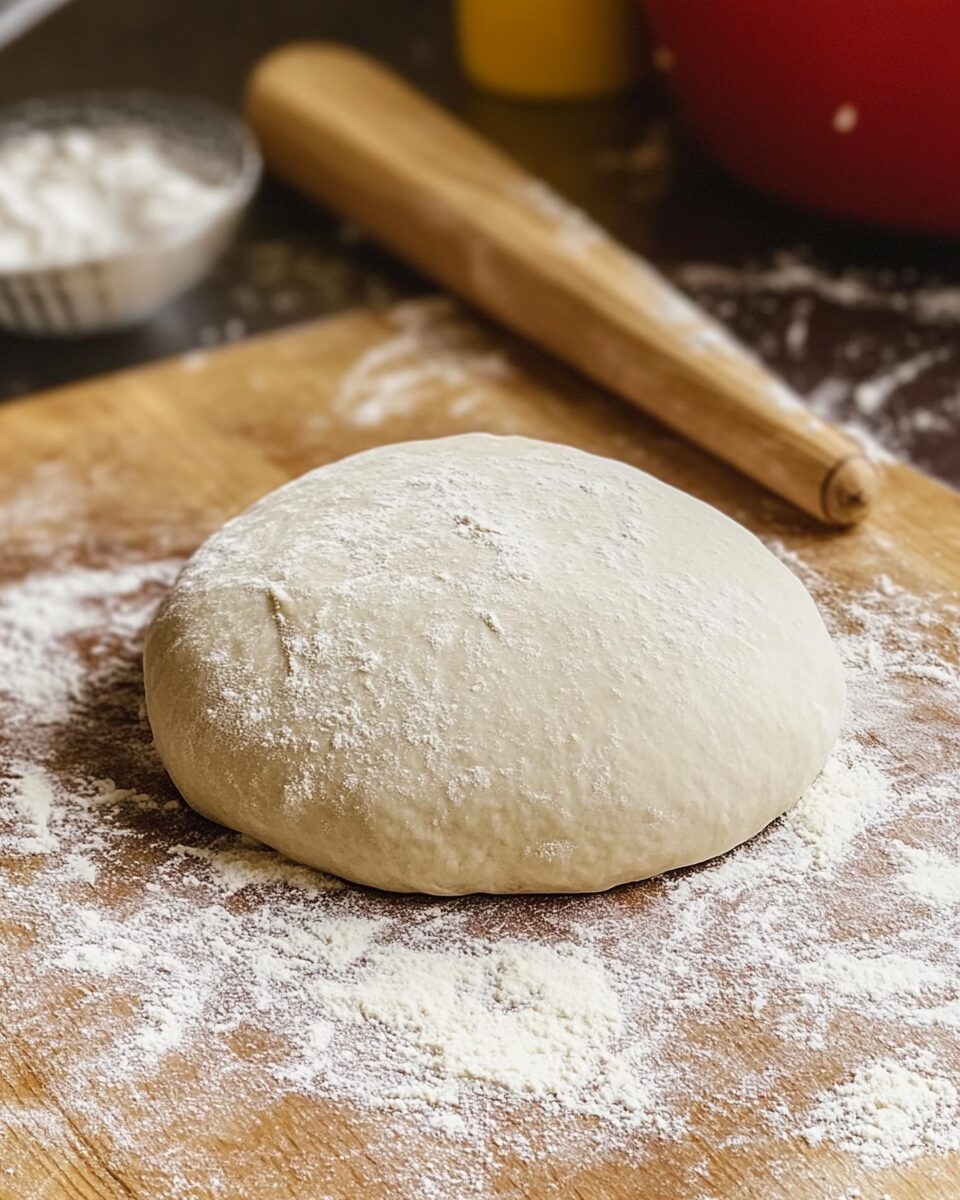There’s nothing quite like the experience of crafting your own pizza dough from scratch. The warm, yeasty aroma of the dough rising and the satisfying texture of kneading bring a personal touch to every pizza you create. This recipe results in a crust that’s crispy on the outside, light and airy on the inside—an ideal base for any topping combination.
Whether you’re planning a family pizza night or impressing guests with your culinary skills, this dough is your ticket to pizza perfection. The versatility of this recipe allows you to experiment with thin crusts or thicker bases, depending on your preference. Pair with a drizzle of olive oil and a sprinkle of your favorite herbs for an extra burst of flavor!
Full Recipe:
Ingredients:
- 500g all-purpose flour (plus extra for dusting)
- 1 tsp salt
- 1 tsp sugar
- 1 packet (7g) instant yeast
- 2 tbsp olive oil
- 325ml warm water
Directions:
- In a large mixing bowl, combine the flour, salt, sugar, and yeast.
- Make a well in the center and add olive oil and warm water.
- Mix the ingredients until they form a rough dough.
- Transfer the dough to a floured surface and knead for 10 minutes, or until smooth and elastic.
- Place the dough in a lightly oiled bowl, cover with a clean kitchen towel, and let rise for 1 hour or until doubled in size.
- Once risen, punch down the dough and divide into two equal portions.
- Roll out each portion on a floured surface into a thin circle or rectangle, depending on your preferred pizza shape.
- Add your favorite toppings and bake at 220°C (425°F) for 12-15 minutes, or until the crust is golden and crisp.
Prep Time: 15 minutes (plus 1 hour rising) | Cooking Time: 15 minutes | Total Time: 1 hour 30 minutes
Kcal: 200 kcal per serving | Servings: 8 servings
Background and Origins
Pizza dough is the foundation of one of the world’s most beloved dishes: pizza. Its origins trace back to Naples, Italy, where bakers perfected the art of combining simple ingredients like flour, water, and yeast to create a versatile base for a variety of toppings. This classic recipe keeps the tradition alive while providing flexibility to cater to modern tastes and dietary preferences.
Why This Recipe Works
This recipe balances simplicity and flavor by using a few basic ingredients to create a dough that’s light yet structurally sound. The addition of olive oil enhances the elasticity of the dough and adds a subtle richness. By allowing the dough to rise properly, the yeast has time to ferment, imparting a depth of flavor and creating the perfect airy texture.
Tips for Success
- Use the Right Flour: All-purpose flour works well, but if you prefer a chewier crust, consider using bread flour for its higher protein content.
- Water Temperature: Ensure the water is warm (around 105°F or 40°C) to activate the yeast without killing it.
- Kneading Technique: Kneading the dough for at least 10 minutes is essential for gluten development, which gives the dough its elasticity.
- Rising Time: For the best flavor, allow the dough to rise for at least an hour. If you have more time, a longer fermentation in the fridge (up to 24 hours) can enhance the flavor even further.
Variations
- Herbed Dough: Mix dried oregano, basil, or rosemary into the flour for a fragrant crust.
- Whole Wheat Option: Substitute half of the all-purpose flour with whole wheat flour for a nuttier taste and more fiber.
- Gluten-Free Alternative: Use a gluten-free flour blend with added xanthan gum for elasticity.
Pairing Suggestions
The beauty of this pizza dough recipe is its versatility. Pair it with classic Margherita toppings (tomato sauce, fresh mozzarella, and basil), or get creative with combinations like BBQ chicken, caramelized onions, and smoked Gouda. For dessert, consider topping the dough with Nutella, fresh fruit, and powdered sugar for a sweet treat.
Fun Fact
The world record for the largest pizza ever made was set in Rome in 2012. It measured over 13,580 square feet and was made using gluten-free dough!
The Science Behind Perfect Pizza Dough
Creating pizza dough is a blend of science and art. The yeast, a microorganism, ferments the sugars in the flour, producing carbon dioxide. This gas gets trapped in the dough, causing it to rise and develop an airy texture. The gluten, a protein found in wheat, forms a stretchy network when kneaded, giving the dough elasticity. These processes ensure that the crust holds its shape while remaining soft and chewy.
How to Store Pizza Dough
- Short-Term Storage: If you’re not ready to use the dough immediately, cover it tightly with plastic wrap or store it in an airtight container in the refrigerator for up to 24 hours. This slow fermentation in the fridge enhances the flavor.
- Long-Term Storage: To freeze the dough, divide it into portions after the first rise, wrap each portion in plastic wrap, and place in a freezer bag. Dough can be frozen for up to 3 months. When ready to use, thaw in the refrigerator overnight and allow it to come to room temperature before rolling.
Common Mistakes to Avoid
- Using Too Much Flour: Adding too much flour while kneading can make the dough stiff and hard to work with. Always aim for a slightly sticky texture.
- Skipping the Rest Period: Allowing the dough to rest after kneading relaxes the gluten, making it easier to roll out.
- Overworking the Dough: Excessive kneading after the dough has risen can break down the gluten structure, leading to a dense crust.
Versatile Uses for Pizza Dough
While pizza is the obvious choice, this dough can be used for so much more:
- Calzones: Fold the dough around your favorite fillings like cheese, pepperoni, and spinach.
- Flatbreads: Roll out thinner and bake as a base for dips or spreads.
- Breadsticks: Shape the dough into sticks, brush with garlic butter, and bake for a delicious appetizer.
- Dessert Pizza: Add sweet toppings like cream cheese, chocolate, and fruits for a fun twist.
Serving and Presentation Ideas
Transform your pizza night into an experience by presenting pizzas on rustic wooden boards or pizza stones. Provide a variety of toppings in small bowls, allowing guests to customize their own pizzas. Consider using fresh herbs as garnish for a pop of color and flavor.
Fun Facts About Pizza
- Pizza was originally considered food for the poor in Naples, Italy, with simple toppings like tomatoes, garlic, and basil.
- October is National Pizza Month in the United States!
- The most expensive pizza ever sold was in Italy for €8,300, topped with lobster, caviar, and 24-karat gold flakes.
Reader Engagement Ideas
To make your article interactive and engaging, ask your readers to share their favorite toppings or photos of their homemade pizzas using your recipe. Include a section for FAQ, like “Can I make the dough gluten-free?” or “What’s the best way to achieve a crispy crust?”
Conclusion
Making pizza dough from scratch is a rewarding process that brings the joy of homemade cooking into your kitchen. This classic recipe offers a perfect balance of simplicity, versatility, and flavor, allowing you to create a crust that’s just as delicious as your favorite pizzeria. Whether you’re hosting a pizza night, experimenting with gourmet toppings, or simply craving a fresh and flavorful meal, this dough is your go-to foundation for culinary creativity.
The beauty of this recipe lies in its adaptability—it welcomes your personal touches, from herbs and spices to alternative flours. With a little time and effort, you’ll have a perfectly golden, crispy, and chewy crust that’s sure to impress family and friends. So, roll up your sleeves, dust off your countertop, and let the magic of homemade pizza dough transform your mealtime experience.
Happy baking, and enjoy every bite of your delicious, handcrafted pizza!






